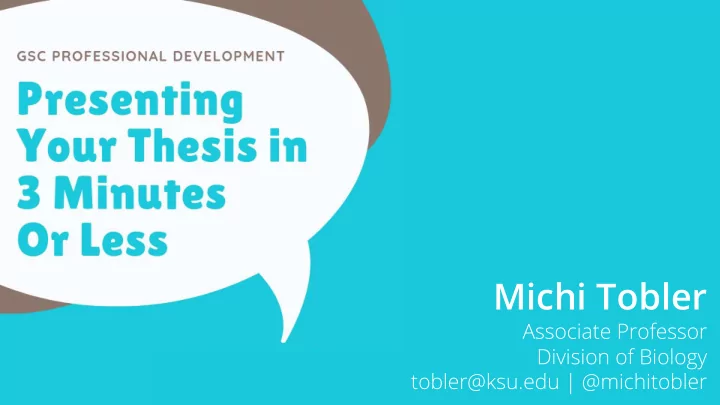

Michi Tobler Associate Professor Division of Biology tobler@ksu.edu | @michitobler
How do you craft your message? How do you tell a story? How do you create visual aids that help?
Who is your audience and what is your communication goal?
The Circle of Knowledge
The Problem The worldview of a scientist
The curse of knowledge You can’t unlearn what you already know
Know thy audience! What common ground do you have with them?
What is your goal?
What do you want them to think? A starting goal: In Intr troduce a a new point t of view An ambitious goal: Cha Challeng nge cur current nt be believes
What do you want them to feel? A starting goal: Sp Spark rk c curio uriosit ity An ambitious goal: In Inspire
What do you want them to do? A starting goal: As Ask a qu questi tion An ambitious goal: Cha Chang nge in in be behavior
Designing your message What worked? What didn’t work? What did you take away?
Storytelling
Why do we tell stories? What are the elements of a story?
Stories help us he us re remember Data vs. narrative: 5% remember statistics in influ luence how we decid ide “What if?” and imagination he help us us s see o ours urselves Passion is a vital ingredient
All of a sudden, CLIMAX! And the world was different. MATURE There was a terrible struggle… …and then something changed Once upon a time… (re)DREAM GROW The START Hero’s A new challenge arises. Journey One day, something happens Time
Innovation You arrive at a new insight MATURE You think you die in the lab…. but - really – you’re not You start out with an established paradigm (re)INVENT GROW The START Scientific You need a new vision to push the boundaries of knowledge Process A new question arises Time
SCIENCE IN A STORY This is a story about (hope, triumph, resilience, realization, commitment, partnership, loss, dreams, perspective, growing up, change, etc.) My audience is My goal is They would care because 5. Then something changed 1. Once upon a time 6. When all of a sudden… CLIMAX! 2. One day ✓ 4. There was a terrible struggle 7. And as a result, the world was different! 3. But something happened
Story prompts How did you become interested? What’s weird or surprising? What’s the tension? What are your motivations? Hopes?
Endings matter Resolved Tie it up in a bow Unresolved Set it up for a sequel Moral Provide the lesson learned Twist Surprise them at the end Crystal ball Show them the future
Story pitfalls The curse of knowledge Awkward, forced or orphaned analogies Lacking emotion
Details
Don’t trouble with words unless you are speaking to a blind man
Why think about design? Design communicates Design engages
Sim × plic × i × ty [sim-plis-i-tee] noun
Surface (non-sulfidic) 4H Surface (sulfidic) 3H P < 0.001 Cave (non-sulfidic) 2H Cave (sulfidic) 1H 0.04 0.06 0.08 0.10 0.04 0.06 0.08 0.10 Relative eye size Eye diameter/standard length
Choosing the right visuals depends on audience and context Who? Who is your audience? What’s your relation to the audience? What? What do you want your audience to think/feel/do? How? How are you communicating with your audience?
Visual representations need to be appropriate and honest
Visual representations need to be appropriate and honest
Visual representations need to be appropriate and honest
Minimize the audience’s cognitive load and eliminate distractions
Direct the attention of your audience Make them see what you want them to see before they even know they are seeing it
Direct the attention of your audience
Think like a designer Your visualizations should be intuitive, accessible, and aesthetic
Recommend
More recommend